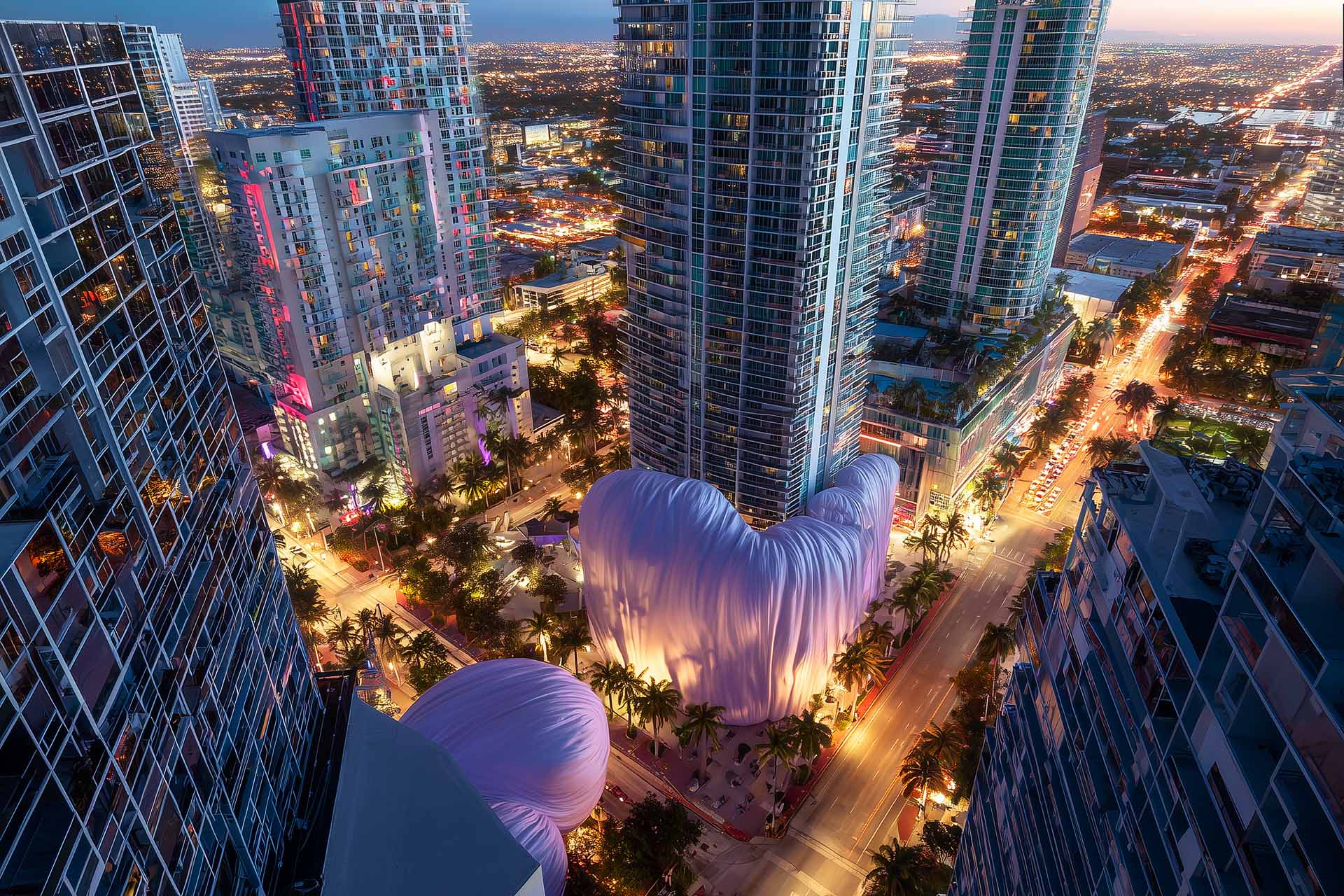

| CANVAS OF PLANS & DRAWINGS |
INTERIOR & DÉCOR, but with a twist |
| HOTELS & RESTAURANTS, beyond mainstream |
Notes on ART |
| Into big AFFAIRS | INSIDERS |
| GLIMPSES | |
Keywords:

In Miami, art no longer hangs politely on the wall. It moves through space like oxygen. It stains glass, infiltrates façades, inhabits the air. The city has become a vast experiment in cultural urbanism, where creativity is not decoration but DNA, and the line between architecture, art, and life itself blurs into a single gesture of seduction. From the sunrise shimmer of Biscayne Bay to the nocturnal glow of Wynwood’s murals, Miami speaks the language of fusion – an alchemy of art, design, and real estate that transforms the built environment into a living, breathing form of expression.
The phenomenon did not arrive overnight. It was midwifed by the gravitational pull of Art Basel Miami Beach, whose 2024 edition generated over $547 million in local impact and drew 80,000 visitors – collectors, curators, developers, architects – all converging beneath the palm-lined artifice of South Beach. For one incandescent week, the city becomes an open-air biennale: hotels metamorphose into galleries, rooftops into salons, and every new building into a manifesto. Developers observed, learned, and adapted – realizing that culture, properly staged, yields a return as measurable as square footage. In Miami, art is capital, and emotion has become an asset class.
Few places embody this equation with the theatricality of the Faena District. Conceived by the Argentine visionary Alan Faena, and realized with OMA’s Rem Koolhaas and Foster + Partners, the project reimagines urbanism as opera – a choreography of architecture, performance, and myth. The Faena Forum, that alabaster drum of civic imagination, stands as both temple and theater, hosting symposia, performances, and installations that ripple out into the surrounding hotel, residences, and plaza. This $1 billion experiment reframes real estate as narrative: every lobby a stage, every corridor a sequence, every sightline a story. What Faena proved is that when art is woven into a project’s conceptual fabric, it ceases to be ornament – it becomes identity, a form of cultural infrastructure that ages like fine architecture, not fashion.
Yet if Faena represents the curated, cinematic face of Miami’s art ecology, Wynwood remains its raw, insurgent heart. Once an industrial ghost zone, it was reborn through pigment and provocation. The Wynwood Walls, a once-rogue experiment, now attract over 3 million visitors annually, a pilgrimage site for the international street-art diaspora. Here, Shepard Fairey, Kenny Scharf, and Futura painted the bones of the city into visibility, transforming anonymity into aura. In a single decade, the neighborhood catalyzed over $1 billion in adjacent property investment, proving that art not only beautifies space – it multiplies it. Yet the Wynwood story is also cautionary: creativity generates capital, and capital has a way of devouring its muse. The challenge for Miami now is not to commercialize authenticity out of existence.
Across the skyline, architecture itself has become Miami’s most public artwork. Herzog & de Meuron’s 1111 Lincoln Road turns a parking structure into a sculptural void – a raw concrete cathedral where light performs on every surface. Their Pérez Art Museum Miami (PAMM) hovers on the bay like a floating garden, its suspended vegetation reducing ambient heat by up to 25% while merging ecology with elegance. The building is both a climate apparatus and a cultural emblem, an architecture of empathy in a city precariously poised between sea and sky. These projects redefine functionality as poetics; they remind us that architecture, at its best, is choreography – the movement of bodies through emotion.
Miami’s real estate market, one of the most fevered on the continent, has turned this aesthetic intelligence into strategy. The city currently counts over 40 branded residential projects – from Bulgari to Aston Martin, from Baccarat to St. Regis – each competing to anchor its brand in cultural cachet. Developers now commission permanent collections, site-specific installations, even artist residencies. Apartments with coherent cultural identities command 15–30% price premiums, and buyers are no longer just investors; they are curators of their own environments. In this new economy, a sculpture in the lobby is not a decorative flourish – it is part of the building’s soul, a story inscribed in stone and steel.
The broader ecosystem sustains this momentum. Institutions like PAMM, the Rubell Museum, and the Institute of Contemporary Art (ICA) attract over one million visitors annually, while the city as a whole welcomed 28 million tourists in 2024, generating $20 billion in cultural and hospitality spending. Each visitor becomes part of a feedback loop in which art drives tourism, tourism drives investment, and investment funds the next chapter of artistic ambition. Culture, in Miami, is not simply an export; it is the circulatory system of the city itself.
The emerging horizon blends sustainability, technology, and narrative design. Artists and architects are collaborating on biophilic façades, installations made from recycled coral limestone, and digital artworks that respond to climate data in real time. AI-assisted curation allows for adaptive environments that shift with light, sound, and human presence. Yet the imperative remains human: to craft spaces that breathe, seduce, and feel alive. The future of luxury will not be measured in marble, but in meaning – in the ability of a space to make its inhabitants sense belonging.
Miami today is both muse and marketplace, theater and laboratory. It is a city that has learned how to monetize imagination without entirely losing its magic. From the lush surrealism of Faena to the anarchic vibrancy of Wynwood, from Herzog’s civic sculpture to the mirrored calm of Biscayne Bay, every surface seems to whisper the same credo: art is not the embellishment of architecture – it is its consciousness. In that fusion lies the promise of a new urban ideal – one in which creativity becomes infrastructure, and cities themselves evolve into works of art.